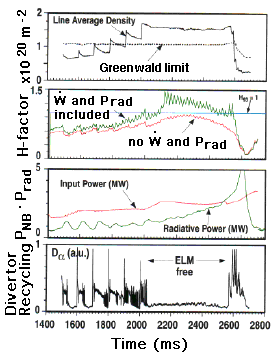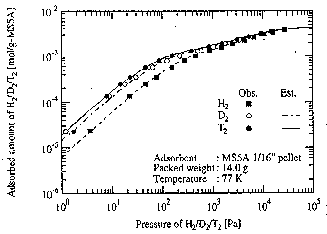IV. FUSION INTERNATIONAL COOPERATIONS
In the area of fusion research and development, Japan is recognized as one of the leading nations of the world together with Europe, USA and Russian Federation. Fusion reactor development is a long-term project which requires large resources both in man-power and in fund. It covers also broad area of science and technology. International cooperation has been recognized quite efficient in avoiding unnecessary duplication and in enhancing world's fusion program. JAERI is carrying out various international cooperation in fusion through multilateral cooperation under International Energy Agency (IEA) in Organization for Economics Cooperation and Development (OECD), International Atomic Energy Agency (IAEA), and bilateral cooperation such as Japan-US cooperation. The multilateral and bilateral cooperation carried out in JAERI are summarized in Table IV. 1-1 and IV. 1-2.
1. Multilateral Cooperations
1.1 IAEA
Under the coordination of International Fusion Research Council, IAEA holds various conferences such as the International Fusion Energy Conference and Technical Committee Meeting (TCM). IAEA also undertakes the Engineering Design Activity (EDA) in the ITER program.
1.2 IEA
Fusion Power Coordinating Committee (FPCC), which is organized under IEA, coordinates the research and development programs for member nations, selects the important areas and reviews the cooperation activities.
Cooperation under the IEA Implementing Agreement among the Three Large Tokamak Facilities pursues personal exchange, holding expert meetings and information exchange among JT-60, JET in EU, and TFTR in USA. Currently six tasks, namely "High-bp Plasma Research", "Disruption Studies", "Divertor Plate Technology", "Neutral Beam Current Drive Research", "Remote Participation in Experiments" and "impurity Content of Radiative Discharges", have been successfully continued. In connection with the Remote Participation in Experiments, Provisional Guidelines for Remote Research on the JT-60 under Co-operation among the Three Large Tokamak Facilities were approved by the Committee. The collaboration among the Three Large Tokamak Facilities has made remarkable achievements and significant contributions to improving tokamak plasma performance and to providing sufficient basis for fusion energy development including ITER.
In the Implementing Agreement on Plasma Wall Interaction in TEXTOR, a plasma-wall interaction research cooperation is carried out utilizing the facility of the TEXTOR tokamak built in Forschungszentrum Julich, Germany.
The agreement for cooperation on fusion materials research is investigate the irradiation damages by applying neutrons from a fission rector to fusion materials. In order to develop fusion materials after a prototype reactor, a conceptual design of a 14 MeV intense neutron source (Fusion Materials and Irradiation Test Facility : IFMIF) is carried out by for parties of Japan, USA, EU and Russia.
The agreement for cooperation on environments, safety and economics is to carry out their evaluation researches which are ongoing with particular emphasis upon environments and safety.
The agreement for cooperation on fusion reactor engineering is to carry out research cooperation and information exchange in terms of neutron engineering, tritium breeding blanket and so on.
Table IV.1-1. Multilateral cooperation in fusion international cooperation at JAERI
2. Bilateral Cooperations
On Japan-US cooperation, Coordinating Committee of Fusion Energy (CCFE) is formed to synthetically coordinate the cooperation activities under Agreement between the government of Japan and the government of the United States on cooperation in Research and Development in Energy and Related Fields. The Japan-US cooperation consists of four frameworks of exchange program, joint program, joint project and plasma physics. In particular, broad joint projects based on agreements and annexes have produced fruit results, playing a leading role in world's fusion research and development.
On Japan-EU cooperation, Agreement for Cooperation between the Government of Japan and the European Atomic Energy Community in the field of controlled thermonuclear fusion was concluded February 1988. Based on this agreement, a joint experiment is carried out in which lower hybrid (LH) wave launcher module built at JAERI are installed into the LH test facility in Cadarache Institute.
With Canada, JAERI carries out information exchange and expert meeting on tritium technology and tokamak research through Atomic Energy Canada Ltd. (AECL). With Australia, information exchange and expert meeting are carried out by holding workshops mainly in the area of diagnostics, experiment and theory for toroidal plasmas. With Russia, information exchange and expert meeting on plasma and fusion are planned under Agreement between the government of Japan and the government of Russia in Research and Development in Science and Technology.
| Bilateral Cooperation | |
| Japan-US | |
| Japan-EU | |
| Japan-Canada | |
| Japan-Australia | |
| Japan-Russia | |
Table IV.1-2. Bilateral cooperation in fusion international cooperation at JAERI
3. Cooperative Program on DIII-D (Doublet III) Experiment
3.1 Highlights of FY 1997 Research Results
Integration of the advanced tokamak concept, which encompasses to acquire the improved confinement in a steady-state with high normalized-beta and a large non-inductive current fraction, and the highly-evolved divertor functions was emphasized in the 1997 experimental campaign at DIII-D. Accordingly, the H-factor of 2 was sustained for 2 seconds in a reversed shear plasma with ELMs under the divertor pumping, by means of the effective modification of edge pressure gradient, mainly in terms of the shaping and edge density control . Furthermore, based on the highest performance discharge in 1996, which recorded the equivalent QDT of 0.32, the product of normalized beta and H-factor was sustained at 7 over 1 s. Intensive studies on the physics of internal transport barrier were also pushed forward.
As to the development of advanced divertor, the geometry and pumping capabilities are modified in multiple steps i.e., the baffle plates and pumps will be installed both at upper and lower divertor in 1999. In the baffled upper pump experiment performed in 1997, high density H-mode plasmas at a density of 1.5 times the Greenwald limit was obtained with the low-field side pellet injection as shown in Fig. IV.3.1-1, which made direct contribution to the ITER Physics R&D. In addition, RI-mode operation was first undertaken, and normalized beta of 4 and H-factor of 3 to 4 were simultaneously obtained at 60% of the Greenwald density.
On the other hand, studies of ECCD experiment was remarkably progressed in 1997. The effective heating and central current drive was demonstrated with 2 MW of 110 GHz EC waves.

Fig. IV.3.1-1 Discharge waveforms of RI-mode
4. Collaborative Activities Concerning Fusion Technologies
4.1 Collaborative Activities on Environmental, Safety, and Economics Aspects of Fusion Power
Designated by the Government of Japan, JAERI has been participating in the IEA Implementing Agreement on a Cooperative Programme on the Environmental, Safety and Economic (ESE) Aspects of Fusion Power. This collaborative activity is carried out by Canada, EURATOM, JAERI, MINATOM and USA since 1992 and extended for another five years in 1997. JAERI is coordinating the tasks on Transient Thermofluid Modeling and Validation Tests and Safety System Study Methodology. Two new tasks on "Socio-Economics Aspects of Fusion Power" and on "Radioactive Waste from Fusion Power" are being considered for collaboration.
4.2 Collaborative Activities on Research and Development of Plasma Wall Interaction in TEXTOR
An IEA implementation for a collaboration program of research and development on plasma wall interaction in TEXTOR is expected up to December 2002. TEXTOR management is under KFA (Forschungszentrum Juelich GmbH), ERM/KMS (Ecole Royale Militaire) Brussels and FOM (Stichting voor Fundamenteel Onderzok der Materie) Nieuwegein under the TEC (Trilateral Euregio Cluster). Japan is a member of the executive committee and NIFS organizing Japanese programs as a cooperation center of Japan. JAERI has been joined the program as a Japanese technical committee member. In this fiscal year, four staff members visited TEXTOR to exchange informations on the design of dynamic ergodic divertor and on plasma edge diagnostics and discuss experimental results.
4.3 Collaborative Activities on Technology for Fusion-Fuel Processing between US-DOE and JAERI
Research and development of technology for Fusion Safety has been carried out at the Tritium Systems Test Assembly (TSTA) of Los Alamos National Laboratory since 1995.
Following the first experiment carried out in FY 1996, the second and third tritium release experiments, which were associated with a 1 Ci tritium release, were carried out to obtain data such as, 1) diffusion process of tritium in a room, 2) conversion rate of tritium gas to tritiated water, 3) tritium behavior when the ventilation system runs for tritium removal from room, and 4) adsorption of tritium on wall materials, etc. The experiments were successfully carried out on December 16, 1997 and March 3, 1998 [4.3-1].
Beta Scintillation Detector (BSD) is a newly proposed technique for measuring total tritium concentration in gases. A new BSD was installed at TSTA to explore this technique. As a result of a series of experiments using various kinds of tritium gas mixture with other hydrogen isotopes, helium and nitrogen, the response of the BSD to tritium was found to be almost unaffected by presence of other gases. This shows that the BSD is a particularly promising technique for tritium accountancy in fusion fuel processing.
For decontamination study, measurement of adsorption isotherms of hydrogen isotopes, particularly pure tritium on Molecular Sieve 5A (MS5A), Molecular Sieve 4A (MS4A) and Activated Carbon (AC) at liquid nitrogen temperature (77 K) was carried out using the constant volume method, in which a measured amount of tritium was adsorbed on the sample stepwise and equilibrium pressure was measured as a function of adsorbed amount. Obtained result with MS5A is shown in Figure IV.4.3-1. The adsorption isotherms of pure tritium on MS5A, MS4A and AC at 77 K can be expressed with the two sites Langmuir equation, and the Langmuir coefficients were obtained as the functions of the reduced mass. These data will be utilized effectively in development of the blanket tritium recovery system and the helium glow discharge exhaust gas cleanup system.

Fig. IV.4.3-1 The adsorption isotherms of H2, D2 and T2 on MS5A at 77 K.
References
[4.3-1] Hayashi T., Kobayashi K., Carlson R.V., et al., 13th Topical Meeting on Technology of Fusion Energy, June 1998, Nashville USA.
4.4 Collaborative Activities on Research and Development of Plasma Facing Components between US and Japan
The JAERI-SNL collaborative activities on the divertor mock-ups have been carried out under the US-Japan Fusion Cooperation Program. In FY 1997, a critical heat flux (CHF) experiment and a thermal cycling test of a Be divertor mock-up were performed in Sandia National Laboratory (SNL). The objective of the experiment is to clarify heat transfer behavior of a cooling tube for the divertor plate over CHF region (post-CHF regime). It was found that the post-CHF regime was clearly appeared in lower flow velocity (~ 1 m/s). The Be divertor mock-up was developed at JAERI. Be armor tiles were bonded onto a Cu heat sink with a HIP method. In the thermal cycling test, a surface heat flux of 3 MW/m2 was cyclically loaded on the mock-up to evaluate the thermal fatigue behavior. The mock-up successfully withstood a heat load of 3 MW/m2, 10 s for 1,000 thermal cycles without failure.
4.5 Collaboration between JAERI and CEA-Cadarache for Lower-Hybrid Antenna Modules
Cooperative activities have been started to obtain a detail outgassing database during a high power and a long pulse RF operation for a launcher design in a future LHCD system from 1993. RF power test was performed at CEA-Cadarache RF Test Facility which allowed high power injection up to 500 kW, under quasi-continuous operation at a frequency of 3.7 GHz. In the first step, the outgassing rate of Dispersion Strengthened Copper waveguide module during RF injection was identified. In the second step of the collaboration from 1995, outgassing rate with mouth modules made of Carbon Fiber Composite (CFC) has been measured to develop heat resistant LH antenna front and the aimed data base was obtained. It was concluded that no external pumping for the antenna is necessary with the appropriate antenna design.
4.6 Collaborative Activities on Research and Development of Plasma Facing Components between EU and Japan
Under the Japan-EURATOM Fusion Agreement, two collaborative activities have been performed. One is the JAERI-CEA collaboration and the other is the JAERI-KFA collaboration. The critical heat flux (CHF) benchmark experiment was performed at CEA. To investigate the influence of the heat flux profile upon CHF, the experiments were carried out with a flat profile and a peak profile which simulates the real heat flux on the ITER divertor plate. It was turned out that the incident CHF with the ITER modified profile is 20 ~ 40 % higher than that with flat profile.
High heat flux experiments on mock-ups developed by KFA were performed at JAERI. In the high heat flux tests of CFC/Cu and B4C/TZM mock-ups, the surface heat flux was stepwise increased to evaluate critical performance. Both mock-ups successfully withstood up to heat loads of 12 ~ 15 MW/m2, 15 s.
4.7 Collaborative Activities on Technology for Tritium Transfer between AECL and JAERI
The objectives of cooperation in the field of controlled nuclear fusion between JAERI and Atomic Energy of Canada Limited (AECL) are to conduct information and personnel exchanges to develop fusion technologies on tritium handling, breeding blanket, and plasma physics. In 1997, a technical meeting was held at the Tritium Process Laboratory, JAERI to discuss the technical items for loading and shipping of tritium from Chalk River Laboratory of AECL. Procedures for accountancy and calibration were discussed and general information was exchanged for mutual understanding of this program. The third shipment of tritium is planned in 1998 based on the contract for purchasing tritium for research and development of tritium handling technology for fusion, which was renewed in March 1998.
5. Other Activities
The mutual information and personal exchanges between JAERI and fusion research institutes in Asian area are rapidly increasing during this several years under significant development on fusion research in this area, especially in China and Korea. These exchanges are performed under STA scientist exchange program (in 1997, three scientists from China for one year and three JAERI scientists to China for two weeks), the scientist invitation program (in 1997, one senior scientist from China for one month), STA and JAERI fellowships and so on. A new framework to make more fruitful cooperation between JAERI and these countries on fusion research field should be prepared under Science and Technology Cooperation Agreement between Japan and these countries.

